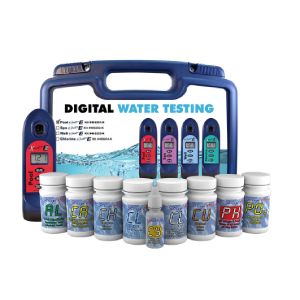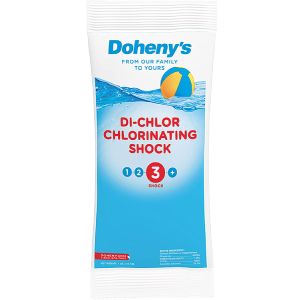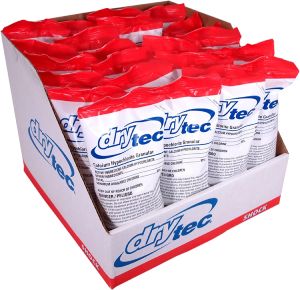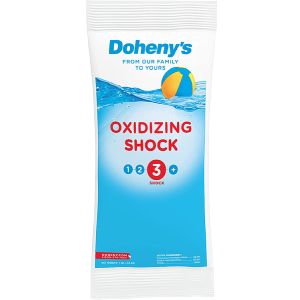Pool Shock Guide
A pool shock can be a pool owners best friend because it can quickly turn a pool around that has been left unbalanced and neglected. Like most things it's easier to prevent problems before they get out of hand and keeping your pool chemistry up to par is no exception to this rule. We'll go over how to shock a pool step by step and when you should be using it in addition to activating the super chlorination feature available with most salt water pool systems.
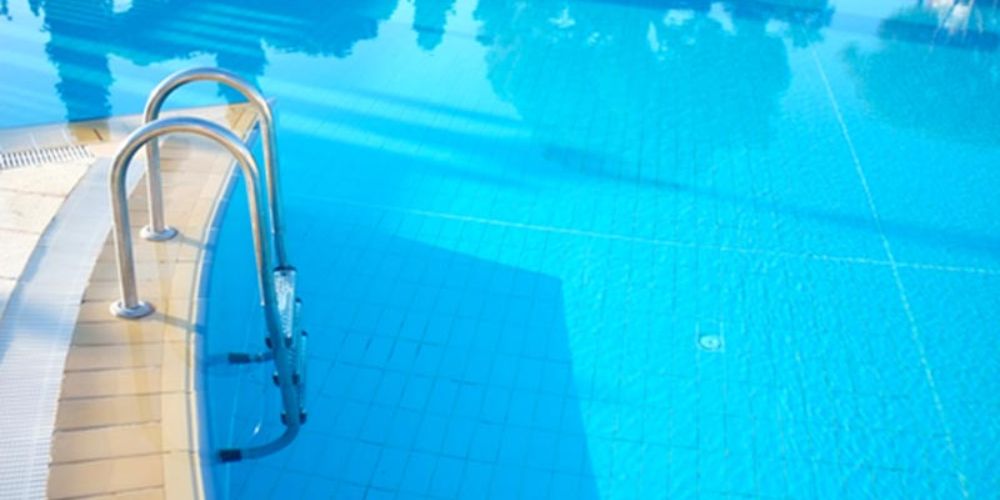
A shock is an oxidizing treatment added to water that destroys ineffective chloramines and other unwanted organisms. In the process it increases free chlorine that will target and destroy biological waste, bacteria and of course pool algae. It's important to keep in mind that it's a lot easier to prevent algae than kill it once it has become established but we will discuss that more below including the use of algaecides.
The Complete Guide to Salt Water Pool MaintenanceEverything you need to know to maintain your salt water pool and keep it running smoothly all season. |
|
Why You Should Shock Your Pool
The way pool shock works is by spiking or elevating the chlorine up to five times the normal operating levels and while doing so killing everything it comes in contact with. It's impossible to have a nice, healthy clean pool if you have contaminants either rendering the chlorine useless or causing cloudy pool water that's really uninviting.
If you own a salt water system you might be familiar with superchlorination if your chlorine generator has this feature. The superchlorination feature is designed to increase chlorine production gradually for short intervals and should be used monthly or as often as needed. It isn't a substitute for shocking but should be used in addition to super chlorinating as a great tool for regular maintenance of your pool similar to a preventative algaecide.
When should I Shock my pool
A pool shock is a necessity when your chloramine levels are high or you already have algae established. At this point you need to reach breakpoint chlorination and that is exactly what pool shock is designed to do. If you know your pool well you can probably tell when your chloramines are too high because of the strong chlorine odour but if you want to be sure you can test your chlorine levels.
It's recommended that you use a good pool test kit that will measure Free Available Chlorine (FAC) and Total Available Chlorine (TAC). The difference between the two levels will give you your Combined Chlorine (CC) or chloramine level. If the difference in these two chlorine levels exceeds 0.3 ppm it is recommended that you shock your pool.
There are many pool professionals that recommend a weekly or bi-weekly shock as an affordable preventative measure and almost as many that say it's a waste of money. It will depend on how much value you place on peace of mind as well as how well you know your pool. A shock is a great tool and reasonably priced so it comes down to personal preference. It's never a bad thing to use before throwing a pool party, during extreme weather or notice algae starting to grow.
ITS Complete Digital Pool Test KitA completely digital pool testing kit that will help you monitor 10 parameters including; salt, chlorine, pH and alkalinity. If you click on this link and make a purchase, we may earn a commission. |
Types of Pool Shock
There are 4 types of pool shock and we'll go through each one so you understand the differences and most importantly how they will affect your pool. Each one operates a little bit differently and could have positive or negative effects on your overall chemistry depending on preexisting conditions in the water. They are available in either powder or liquid form and sold in packets, buckets or in bulk quantities.
- Di-Chlor
- Cal-Hypo
- Non-Chlorine
- Lithium Hypo
1. Di-Chlor
Di-Chlor pool shock contains chlorine and cyanuric acid which is another name for stabilizer. If you use this as a preventative weekly shock you may end up with too much cyanuric acid as a byproduct over time. It's important to recognize if you are having issues with high chlorine stabilizer you might want to switch to a different shock. It's slightly more expensive than calcium hypochlorite and recommended for salt water pool owners.
- Increases cyanuric acid and stabilizer
- 60% chlorine
- No pre-mixing required
- 8 hour turnaround
- Add at night
Doheny's Di-Chlor Pool Shock 100% Professional GradeCalcium-free shock treatment that will prevent algae growth that's great for salt water pools. If you click on this link and make a purchase, we may earn a commission. |
2. Cal-Hypo
Calcium hypochlorite or cal hypo is the most popular shock because it is cheaper than the other options available and gets the job done. It's slow dissolving and should be pre-mixed in a bucket of water to prevent bleaching of the pool liner and help with dissolving. It is often used as a weekly preventative but pool owners with high calcium levels should be aware you are adding calcium every time it is used and want to consider a Di-Chlor Shock instead.
- Increases calcium
- 65% chlorine
- Pre-mixing recommended
- 8 hour turn around
- Add at night
DryTec Calcium Hypochlorite Chlorine Shock TreatmentA super-fast acting chlorine boost shock treatment that contains 68% calcium hypochlorite. If you click on this link and make a purchase, we may earn a commission. |
3. Non-Chlorine
Potassium peroxymonosulfate is the technical name for an oxidizing pool shock that doesn't contain any chlorine. It is ideal for pools that use bromine as the sanitizer but it can be used in chlorine sanitized pools. It is a convenient product that works ultra-fast and is easy to use but it can be quite costly especially if you are using it as part of your regular pool maintenance.
- No chlorine
- No pre-mixing required
- 15 minute turn around
- Add anytime of the day
Doheny's Chlorine-Free Oxidizing Pool ShockOxidizing pool shock with no chlorine that's quick-dissolving and safe for all pool types. If you click on this link and make a purchase, we may earn a commission. |
4. Lithium Hypochlorite
Lithium hypochlorite is an option that isn't for everyone mainly because it is a lot more expensive than it's calcium based cousin. The only reason that it would be worth paying almost three times more for is if you have hard water or high calcium preexisting in your pool. It can be added directly to the pool because it dissolves instantly and won't bleach vinyl liners.
- 35% chlorine
- No pre-mixing required
- 8 hour turn around
- Add at night
How to Shock a Pool
Shocking a pool is one of the easiest things you can do to improve the health of your pool and keep it that way all season long. Depending on which type you use, chlorine-free shock being the easiest and fastest acting, you should always follow the manufacturers instructions. If you are shocking as part of your regular pool maintenance routine you will likely only require one pound of shock at a time. If you are trying to remedy a green pool or you've had an unusually high bather load you may require more.
Required Equipment
- Shock
- Protective clothing, gloves and eyewear
- Empty 5 gallon bucket and stir stick (cal hypo shock only)
Important
- Always shock at night unless using a non-chlorine shock.
- Keep pool circulation system running overnight or as long as the algae killing process takes.
- Keep the filter clean including backwashing for the entire algae killing process.
Pool Shocking Step by Step
- Fill the bucket with water from the pool and slowly add 1 pound of shock to the bucket. Never add water to a chemical.
- Stir the bucket well for a couple minutes or until all the chemical is dissolved.
- Pour the mixture into the water slowly, evenly and as close to the water as possible to avoid splashing. You may want to pour it near the return line so the jets spread the chemical or you can walk around the edge of the pool. Never add shock directly to the skimmer.
- Just before the bucket is empty it's a good idea to refill it with water and stir incase some of the chemical didn't dissolve completely. You will need to repeat these steps for every 1 pound of shock you use and never dissolve more than one bag at a time.
- Wait the recommended amount of time before entering the pool which is at least 8 hours unless you are using a non-chlorine pool shock. Always test the water after this process to ensure that chlorine levels have dropped and are safe to swim in again.
Disclaimer
Please use all appropriate and proper safety precautions when attempting projects on this website. All projects are attempted at the reader's own risk.
Salt Water Pool and Spa™ participates in the Amazon Services LLC Associates Program, as an Amazon Associate we may earn a commission from qualifying purchases.

